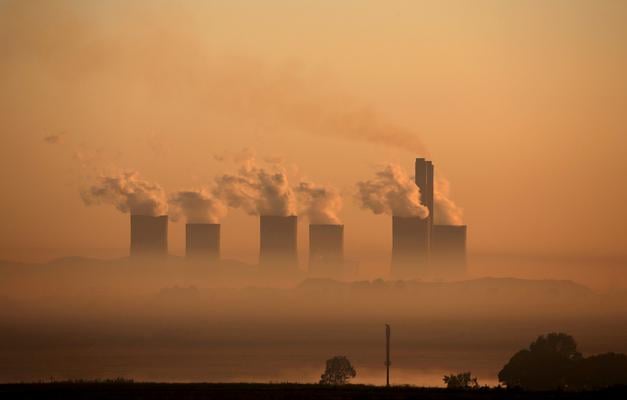Kriel in Mpumalanga now the second highest SO2 emissions hotspot in the world
The area's high levels of pollution are a direct result of a concentration of coal power plants there, a new study found.

FILE PHOTO: Steam rises at sunrise from the Lethabo Power Station, a coal-fired power station owned by state power utility Eskom near Sasolburg, South Africa, March 2, 2016. Picture: REUTERS / Siphiwe Sibeko
In the latest study to illustrate alarmingly high levels of air pollution caused by humans, the area around Kriel in Mpumalanga is now the world’s second biggest sulphur dioxide (SO2) emissions hotspot in the world. This is according to new data from NASA satellites, released on Monday morning.
Greenpeace India commissioned a study using NASA satellites to track SO2 hotspots around the world, the environmental organisation said in a statement.
The area’s high levels of pollution are a direct result of a concentration of coal power plants there, the study found. Eskom has a fleet of 12 coal power stations, all located in the Highveld Priority Area in Mpumalanga and Gauteng.
The government declared the region a “priority area” because of the environmental risk from air pollution there.
The new data shows that the Highveld SO2 emissions are beaten only by the enormous nickel smelters at Norilsk in Russia – one of the 10 most polluted places on Earth according to environmental non-profit organisation, the Blacksmith Institute.
In third place, according to the new NASA data, is an enormous petrochemicals plant at Zargoz in Iran.
According to Greenpeace, power plants and industries which burn oil and gas are responsible for two thirds of SO2 emissions which can be linked to human activity, in the world. Oil refineries and metal smelters – like the one in Russia – are also major sources of SO2.
A previous Greenpeace study also showed that Mpumalanga has one of the world’s highest rates of nitrogen dioxide.
The South African government is already being sued over its alleged failure to act on the toxic air in the Highveld. The lawsuit has been brought by environmental activist group groundWork and Mpumalanga community organisation Vukani Environmental Justice Movement in Action, represented by the Centre for Environmental Rights (CER).
They want the court to declare the air pollution in the area a violation of people’s right to an environment that is not harmful to their health or well-being, as enshrined in Section 24 of the Constitution.
As part of that suit, the applicants submitted a new study that showed that Eskom’s coal fleet as well as Sasol’s coal-to-liquids plant in Secunda, and the NatRef refinery in Sasolburg, contributed to the vast majority of air pollution in the Highveld in 2016. These 14 facilities were estimated to have caused between 305 and 650 early deaths in the area in 2016, according to the study. It was conducted by an expert in air pollution, Dr Andy Gray.
This follows another lawsuit in which groundWork, represented by the CER, sued former Minister of Environmental Affairs, Nomvula Mokonyane, for trying to double the amount of S02 that coal-fired boilers can emit without public comment.
The notice to change the emissions standards was withdrawn, but re-published for comment in May this year. If passed, it would allow the doubling of SO2 emissions by big coal-burners like Eskom and Sasol from April 1, 2020. Activists say South Africa’s SO2 emissions standards will be 10 times weaker than India’s, and 28 times weaker than China’s, if these plans go ahead.
According to the CER, a recent study conducted by Lauri Myllyvirta, lead analyst at Greenpeace’s Global Air Pollution Unit, shows that about 3 300 premature deaths could be caused by doubling the SO2 standards over time. This would have “profound” health effects, especially on the elderly, children, pregnant women and those who already have illnesses such as asthma and lung disease.
In a statement on Monday, Myllyvirta said: “The burning of fossil fuels such as coal, oil and gas is the largest source of emissions of SO2, resulting in disastrous air pollution and premature deaths. Clean energy could save billions of dollars in health costs and thousands of lives every year. It’s fundamental that governments rapidly transition away from fossil fuels and set stronger emission standards as they shift over to sustainable alternatives.
For more news your way, download The Citizen’s app for iOS and Android.







